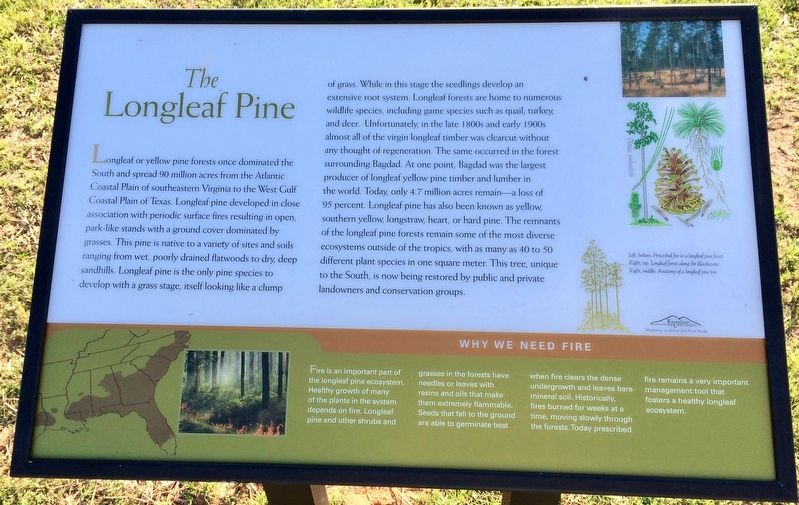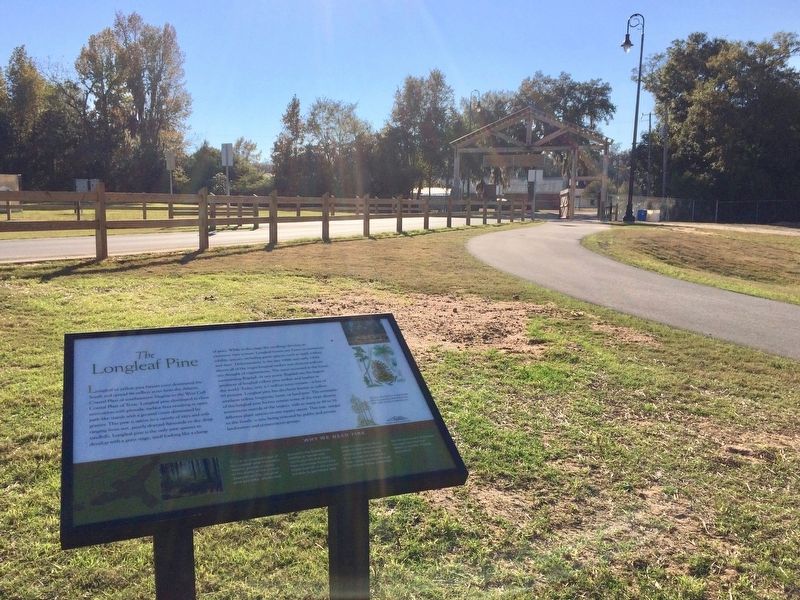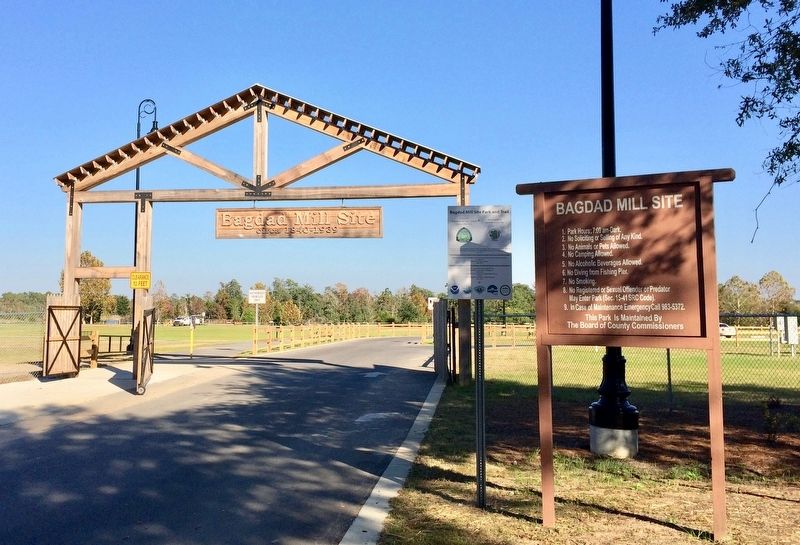Bagdad in Santa Rosa County, Florida — The American South (South Atlantic)
The Longleaf Pine
Longleaf or yellow pine forests once dominated the South and spread 90 million acres from the Atlantic Coastal Plain of southeastern Virginia to the West Gulf Coastal Plain of Texas. Longleaf pine developed in close association with periodic surface fires resulting in open park-like stands with a ground cover dominated by grasses. This pine is native to a variety of sites and soils ranging from wet, poorly drained flatwoods to dry deep sandhills. Longleaf pine is the only pine species to develop with a grass stage, itself looking like a clump of grass. While in this stage the seedlings develop an extensive root system. Longleaf forests are home to numerous wildlife species, including game species such as quail, turkey, and deer. Unfortunately, in the late 1800s and early 1900s almost all of the virgin longleaf timber was clearcut without any thought of regeneration. The same occurred in the forest surrounding Bagdad. At one point, Bagdad was the largest producer of longleaf yellow pine timber and lumber in the world. Today, only 4.7 million acres remain a loss of 95 percent. Longleaf pine has also been known as yellow southern yellow longstraw heart, or hard pine. The remnants of the longleaf pine forests remain some of the most diverse ecosystems outside of the tropics, with as many as 40 to 50 different plant species in one square meter. This tree, unique to the South, is now being restored by public and private landowners and conservation groups.
Why We Need Fire
Fire is an important part of the longleaf pine ecosystem. Healthy growth of many of the plants in the system depends on fire. Longleaf pine and other shrubs and grasses in the forests have needles or leaves with resins and oils that make them extremely flammable. Seeds that fall to the ground are able to germinate best when fire clears the dense undergrowth and leaves bare mineral soil. Historically, fires burned for weeks at a time, moving slowly through the forests. Today prescribed fire remains a very important management tool that fosters a healthy longleaf ecosystem.
Captions:
Left, bottom: Prescribed fire in a longleaf pine forest
Right, top: Longleaf forest along the Blackwater
Right, middle: Anatomy of a longleaf pine tree
Erected 2016 by Bagdad Waterfronts Florida Partnership, Inc.
Topics. This historical marker is listed in these topic lists: Horticulture & Forestry • Natural Resources.
Location. 30° 36.26′ N, 87° 1.987′ W. Marker is in Bagdad, Florida, in Santa Rosa County. Marker can be reached from Main Street, 0.1 miles east of Forsyth Street. Located within the Bagdad Mill Site Park. Touch for map. Marker is at or near this postal address: 6953 Main Street, Bagdad FL 32530, United States of America. Touch for directions.
Other nearby markers. At least 8 other markers are within walking distance of this marker. A New Century (here, next to this marker); The Architecture of Bagdad (within shouting distance of this marker); Bagdad Mill Site Park (about 300 feet away, measured in a direct line); Bagdad After the Mill (about 300 feet away); The Early History of Bagdad (about 300 feet away); Animals Along the Blackwater River (about 400 feet away); Native Trees (about 500 feet away); Submerged Aquatic Vegetation (about 500 feet away). Touch for a list and map of all markers in Bagdad.
Regarding The Longleaf Pine. Some of the timber land, that was part of the former mill, was purchased by the federal government. The land was later transferred to the State of Florida and became part of the nearby Blackwater River State Forest.
Related marker. Click here for another marker that is related to this marker.
Credits. This page was last revised on June 20, 2018. It was originally submitted on December 8, 2016, by Mark Hilton of Montgomery, Alabama. This page has been viewed 473 times since then and 25 times this year. Photos: 1, 2, 3. submitted on December 8, 2016, by Mark Hilton of Montgomery, Alabama.


